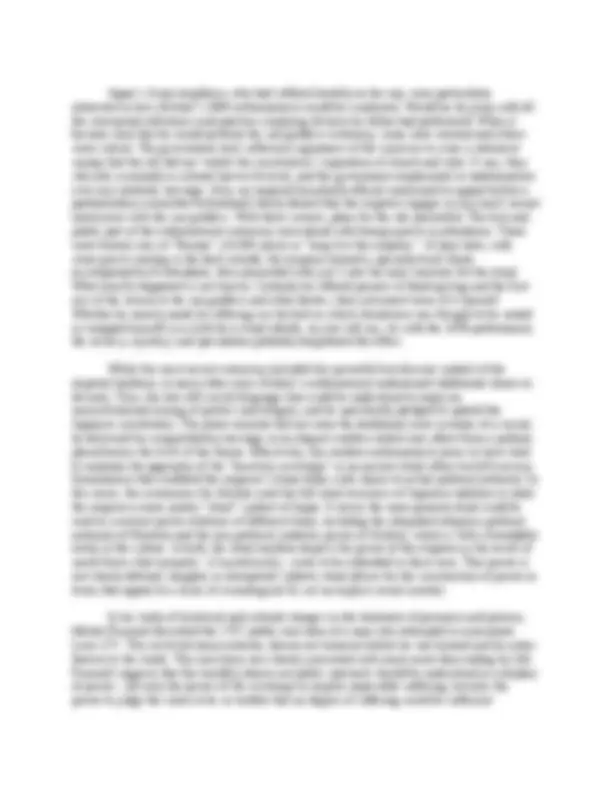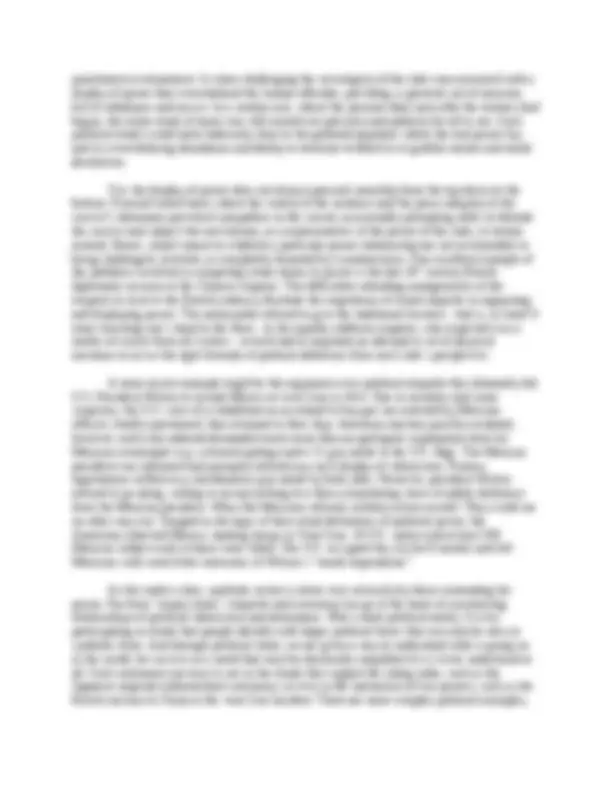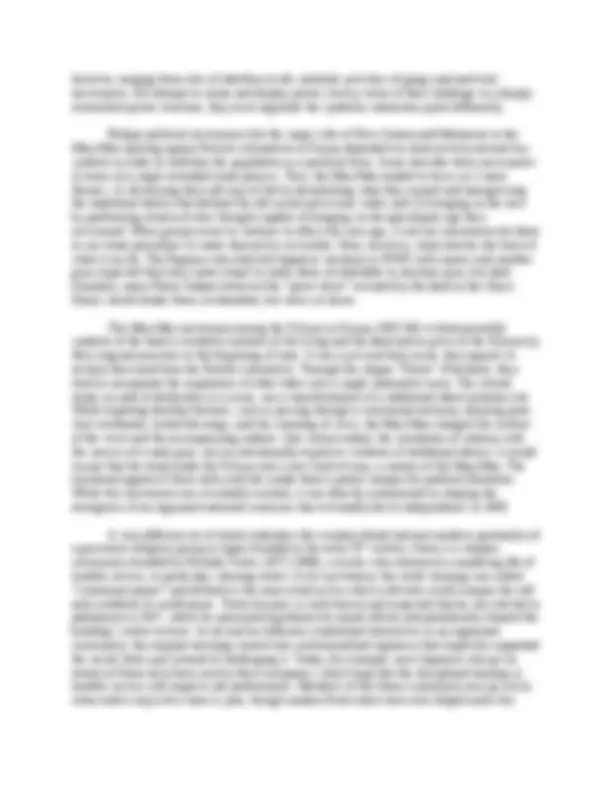





Study with the several resources on Docsity

Earn points by helping other students or get them with a premium plan


Prepare for your exams
Study with the several resources on Docsity

Earn points to download
Earn points by helping other students or get them with a premium plan
Community
Ask the community for help and clear up your study doubts
Discover the best universities in your country according to Docsity users
Free resources
Download our free guides on studying techniques, anxiety management strategies, and thesis advice from Docsity tutors
The concept of political rituals as practices that construct, display, and promote power through symbolic means. Political rites are argued to not only give form to power but also construct it, making it tangible and effective. Examples range from traditional ceremonies like the queen's coronation and the swazi newala rite to modern displays like national salutes and political suicides. The document also discusses the strategies of display and the role of ritual in defining power and establishing political order.
Typology: Study notes
1 / 6

This page cannot be seen from the preview
Don't miss anything!




S/A 4074: Ritual and Ceremony Lecture 21: Political and Legal Rites Today we look first at political, and then legal rites. Political rituals include ceremonial practices that specifically construct, display, and promote the power of political institutions (e.g. king, state, village elders) or the political interests of distinct constituencies and subgroups. Geertz argued that political rituals should not simply be thought of as giving form to power, they actually construct it. The king’s cult creates the king, defines kingliness, and orchestrates a cosmic framework within which the social hierarchy headed by the king is seen as natural and right. Political rites are elaborate arguments about the very nature of power that make it tangible and effective. Hence, political rituals would include the Queen’s coronation, the Swazi Newala Rite, the Babylonian Akitu festival, Aztec sacrifice, and the Kwakiutl potlach. Beyond this, we might also add national salutes like the U.S. pledge of allegiance of the Nazi salute, the public execution of a convict, state funerals, the cross-burnings of the Ku Klux Klan, political suicides, oaths and initiations indispensable to revolutionaries like the Mau Mau in Kenya, and the actions of suicide bombers. Generally, political rites define power in a 2 dimensional way: (1) they use symbols and symbolic action to depict a group as a coherent and ordered community based on shared values and goals; (2) they demonstrate the legitimacy of those values and goals by establishing their iconic nature in relation to the perceived values and order of the cosmos. Thus, political ritual is something very different from the use or threat of coercive physical force, though those who claim power can do so with both weapons and ritual, and ritual itself can include the display of weapons. However, it is through ritual that those claiming power demonstrate how their interests are in the natural, real, or fruitful order of things. When effective, the symbolic imagery and structural processes of political ritual can transform the arbitrary and conventional into what appears to be necessary and natural. One of the most prominent strategies is that of display. Excessive displays of wealth, material resources, mass approval, or record-high productivity all tangibly testify to the fruitful fit between the particular social leadership and the way things should be. When the Soviet Union paraded its military might through Red Square on May day, the number of weapons, their intimidating proportions and alleged technological sophistication, and the size of the approving crowds certainly helped create much of the power of the premiers and party presidents watching from the Kremlin. The system that could produce such products, leaders, approving crowds, and national pride was accorded either a “rightness” or at least some degree of acceptance. When ritual is the principal medium by which power relationships are constructed, the power is usually perceived as coming from beyond the immediate control of the human community. Hence, more ritual attended the coronation of Louis XVI, who claimed the “divine right of kings,” than usually accompanies the inauguration of an American president or a British prime minister. As in the “theater-state” of ancient Java, traditional monarchs spend most of their time demonstrating that their court is a “microcosm of the supernatural order...and the material embodiment of political order.” The complex ritual life of the court creates a reflection of the solemn order of the universe and a model for the appropriate social order. Even with modern
rulers who govern with the consent of the governed, there are still overt ritual appeals to higher forces and designs, although the language of formal moral responsibility, rather than cosmology, is more apt to validate and control this type of authority. Hence, after being sworn in before God and the nation, an American president is often at pains to demonstrate in his speech the moral leadership that transforms the electoral choice into something other than an accident of history. In its cosmological mode, this “dramaturgy of power” involves the creation of comprehensive ritual systems that raise the ruler above normal human interaction. The restriction of admittance to the ruler’s presence and the decorous regulation of behavior required of all of those admitted create relationships that actually empower the ruler. In such a system, the distinctive status and power of the ruler are predicated in part on the distance separating him or her from other people. The Japanese emperor, continuing what may be the oldest continuing state rituals in the world, is a good example. This involves a cult in which the emperor was accorded an overt quasi-divine status. That, in turn, mandated certain forms of loyalty and activities of respect. Since the end of WWII, when Emperor Hirohito made a radio speech renouncing all claims to divinity, and when a constitutional government was established, the Japanese have expressed some ambivalence about how to treat their monarch. This came to the fore in plans for the enthronement of Crown Prince Akihito a year after Hirohito’s death in 1989. Against a backdrop of imperial genealogies that identified Akihito as the 125th^ emperor of Japan, questions arose about the traditional enthronement ceremonies, which were not all as ancient as “tradition” implied, and the types of claims these ceremonies make about the emperor and Japan. Of particular interest was the question of whether the crown prince would perform the “great food tasting” ritual associated with the conferral of divine status. Imperial claims to divinity - to being a living god - reach back into Japan’s most ancient political history, though Japanese notions of “divinity” are not the same as Judeo-Christian-Islamic concepts of a single transcendent being. As heavenly sovereign, Japanese emperors routinely made offerings to the ancestress of the imperial clan, the sun goddess Amaterasu, and the numerous other gods of Japan. They would offer rice in the form of rice wine, which has been a central symbol of the links the Japanese see among humans, gods, the land, and purity. Traditionally, the emperor himself has cultivated a small plot of rice on the palace grounds, and the planting and harvesting of this rice for court ceremonies have been ritual events themselves. In one ceremony, the emperor presents food offerings and rice wine to the 10,000 gods of Japan in 2 identical but separate chambers, each containing a mat, a couch with a coverlet, and a small table. He waits while the gods partake of the food and then sips sake in an act of communion. Layers of ancient mythology, variously nuance these activities as a testing of the emperor, a sacred marriage in which he is the bridegroom, or the descent of the divine grandson of the sun goddess to be reborn in the human form of the emperor. Still, the historical evidence also suggests that this ritual has other connotations, such as filiality and connection to the land. It had been performed by Hirohito in 1928, at a time when the government was run by militant nationalists, and the imperial throne, which had regained real power only in the second half of the 1800's, was actively expanding its doctrine of the imperial divinity as the head of a state cult. There was little official explanation of the meaning of the 1928 ritual and, it turned out, no definitive historical account of even exactly how to do it. The vague and flexible mysticism that came to be attached to the ritual was probably the most politically effective interpretation.
punishment or atonement. A crime challenging the sovereignty of the ruler was answered with a display of power that overwhelmed the human offender, providing a spectacle not of measure, but of imbalance and excess. In a similar case, where the prisoner died soon after the tortures had begun, the entire ritual of terror was still carried out precisely and publicly for all to see. Such political rituals could make hideously clear to the gathered populace where the real power lay, and its overwhelming abundance and ability to terrorize testified to its godlike nature and moral absolutism. Yet, the display of power does not always proceed smoothly from the top down to the bottom. Foucault noted times where the cruelty of the sentence and the pious integrity of the convict’s demeanor provoked sympathies in the crowd, occasionally prompting mobs to liberate the convict and subject the executioner, as a representative of the power of the ruler, to torture instead. Hence, rituals meant to establish a particular power relationship are not invulnerable to being challenged, inverted, or completely thwarted by counteractions. One excellent example of the problems involved in competing ritual claims to power is the late 18th^ century British diplomatic mission to the Chinese emperor. The difficulties attending arrangements of the emperor to receive the British embassy illustrate the importance of ritual etiquette in organizing and displaying power. The ambassador refused to give the traditional kowtow - that is, to kneel 3 times touching one’s head to the floor - to the equally stubborn emperor, who expected it as a matter of course from all visitors - so both had to negotiate an alternative set of physical exertions to act as the right formula of political deference from each side’s perspective. A more recent example might be the arguments over political etiquette that ultimately led U.S. President Wilson to invade Mexico at vera Cruz in 1914. Due to mistakes and some suspicion, the U.S. crew of a whaleboat on an errand to buy gas was arrested by Mexican officers, briefly questioned, then returned to their ship. American reaction quickly escalated, however, and a rear admiral demanded much more than an apologetic explanation from his Mexican counterpart (e.g. a formal apology and a 21 gun salute to the U.S. flag). The Mexican president was informed and promptly refused any such display of submission. Furious negotiations settled on a simultaneous gun salute by both sides. However, president Wilson refused to go along, willing to accept nothing less than a humiliating show of public deference from the Mexican president. When the Mexicans refused, military action ensued. They could see no other way out. Trapped in the logic of their ritual definitions of political power, the Americans attacked Mexico, landing troops in Vera Cruz. 19 U.S. sailors and at least 200 Mexican soldiers and civilians were killed. The U.S. occupied the city for 6 months and left Mexicans with some bitter memories of Wilson’s “moral imperialism.” As this makes clear, symbolic action is taken very seriously by those contending for power. Far from “empty ritual,” etiquette and ceremony can go to the heart of constructing relationships of political submission and dominance. Rites create political reality. It is by participating in rituals that people identify with larger political forces that can only be seen in symbolic form. And through political ritual, we are given a way to understand what is going on in the world, for we live in a world that must be drastically simplified if it is to be understood at all. Such sentiments are easy to see in the rituals that support the ruling order, such as the Japanese imperial enthronement ceremony, or even in the interaction of two powers, such as the British mission to China or the vera Cruz incident. There are more complex political examples,
however, ranging from rites of rebellion to the symbolic activities of gangs and nativistic movements. All attempt to create and display power, but by virtue of their challenge to a deeply entrenched power structure, they must negotiate the symbolic interaction quite differently. Religio-political movements like the cargo cults of New Guinea and Melanesia or the Mau-Mau uprising against British colonialism in Kenya depended on ritual activity around key symbols in order to mobilize the population as a political force. Some describe these movements in terms of a single extended ritual process. Thus, the Mau-Mau tended to focus on 2 main themes: (1) destroying their old way of life by demolishing what they owned and transgressing the traditional taboos that defined the old social and cosmic order; and (2) bringing on the new by performing ritual activities thought capable of bringing on the apocalyptic age they envisioned. When groups resort to violence to effect this new age, it was not uncommon for them to use ritual procedures to make themselves invincible. Here, however, ritual reaches the limit of what it can do. The Papuans who attacked Japanese warships in WWII with canoes and wooden guns expected their holy water rituals to make them invulnerable to machine guns, but died. Similarly, many Plains Indians believed the “ghost shirts” revealed by the dead in the Ghost Dance would render them invulnerable, but were cut down. The Mau-Mau movement among the Kikuyu in Kenya (1952-56) evoked powerful symbols of the land as motherly nurturer of the living and the dead and as given to the Kikuyu by their original ancestors at the beginning of time. It was a just and holy cause, they argued, to reclaim their land from the British colonialists. Through the slogan “Uhuru” (Freedom), they tried to incorporate the aspirations of other tribes into a single nationalist cause. The central ritual, an oath of dedication to a cause, was a transformation of a traditional tribal initiation rite. While repeating familiar features, such as passing through a ceremonial archway, donning goat- skin wristbands, lustral blessings, and the swearing of vows, the Mau-Mau changed the content of the vows and the accompanying ordeals. One critical ordeal, the simulation of sodomy with the carcass of a male goat, was an intentionally repulsive violation of traditional taboos; it would ensure that the ritual made the Kikuyu into a new kind of man, a warrior of the Mau-Mau. The emotional appeal of these oaths and rites made them a potent weapon for political liberation. While this movement was eventually crushed, it was directly instrumental in shaping the emergence of an organized national consensus that eventually led to independence in 1963. A very different set of rituals embodies the countercultural and anti-modern spirituality of a grassroots religious group in Japan founded in the early 20th^ century. Ittoen is a utopian community founded by Nishida Tenko (1872-1968), a mystic who embraced a wandering life of humble service, in particular, cleaning toilets. In his movement, this toilet cleaning was called “communal prayer” and defined as the main ritual act by which a devotee could conquer the self and contribute to world peace. Tenko became so well-known and respected that he was elected to parliament in 1947, where he sponsored legislation for moral reform and periodically cleaned the building’s toilets to boot. As he and his followers established themselves as an organized community, the original teachings turned into institutionalized regimens that implicitly supported the social status quo instead of challenging it. Today, for example, most Japanese who go on retreat at Ittoen have been sent by their companies, which hope that the disciplined training in humble service will improve job performance. Members of the Ittoen community now go out to clean toilets only a few times a year, though modern flush toilets have also helped make this